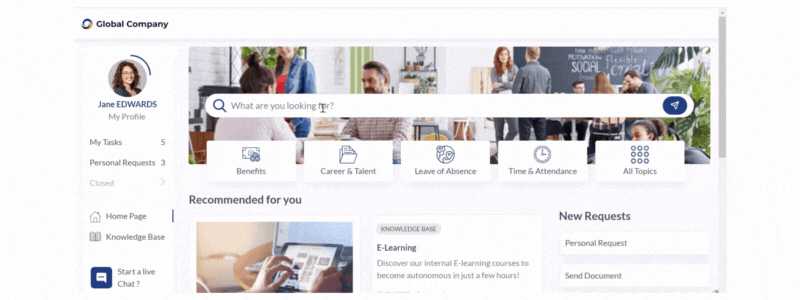A Game-Changer for Employee Experience
In the fast-paced world of today, with AI changing the game, innovations continue to redefine the way we interact with information in our day-to-day lives. One of the innovations that has revolutionized the search experience is "natural language search." For those unfamiliar with the term, natural language search involves the use of everyday language to interact with search engines and databases, making information retrieval more intuitive and user-friendly.
What is Natural Language Search?
Natural language search allows users to input queries in the same way they would ask questions or find information in everyday conversation. Instead of relying on rigid, keyword-based queries, users can articulate their questions or requests in a more natural and conversational manner. This technology leverages advanced algorithms and natural language processing (NLP) to understand and interpret user queries, delivering more relevant and accurate results.

Applications in Human Resources:
The use of natural language search in Human Resources (HR) is transforming the way employees and HR professionals access information, streamline processes, and improve overall employee experience. Here are some examples of how natural language search is making waves in HR:
-
Employee Self-Service: Natural language search enables employees to find relevant information on HR policies, benefits, and procedures effortlessly. Instead of navigating through complex HR portals, employees can simply ask questions, such as "What are the maternity leave policies?" or "How can I update my contact information?" This empowers employees to take control of their HR-related queries independently.
-
Job Search and Recruitment: HR departments utilize natural language search in recruitment processes to efficiently sift through resumes and candidate profiles. By inputting natural language queries like "Candidates with experience in project management," recruiters can quickly identify suitable candidates, streamlining the hiring process and saving A LOT of time.
-
Performance Management: During performance reviews, employees can use natural language search to access feedback, set goals, or seek guidance on improving their performance. This fosters a transparent and collaborative environment where employees actively engage with their performance data and contribute to their professional development.
-
Training and Development: When employees are seeking information on training programs or skill development opportunities, they can use natural language search to discover relevant courses or resources. For instance, an employee might inquire, "What training options are available for leadership development?" This personalized approach enhances the learning experience and encourages continuous skill enhancement.
Benefits for Employee Experience:
The incorporation of natural language search in HR processes offers several benefits, ultimately enhancing the overall employee experience:
-
Accessibility and Inclusivity: Natural language search eliminates barriers to information access, making it more inclusive for employees with varying levels of technical proficiency. It ensures that all employees, regardless of their familiarity with complex HR systems, can easily find the information they need.
-
Time Efficiency: By simplifying the information retrieval process, natural language search saves employees and HR professionals valuable time. This efficiency contributes to a more productive work environment and allows HR teams to focus on strategic initiatives rather than routine administrative tasks.
-
Improved User Engagement: The conversational nature of natural language search promotes higher user engagement. Employees are more likely to actively participate in HR processes when they can interact with systems in a way that mirrors natural communication, leading to increased satisfaction and collaboration.
-
Data-Driven Decision-Making: HR professionals can leverage the insights gathered from natural language search analytics to understand common employee queries, identify trends, and tailor HR services to better meet the needs of the workforce. This data-driven approach enhances HR decision-making and contributes to a more responsive and employee-centric HR ecosystem.
- Bridging the Gap Between HR and Employees: Natural Language Search (NLS) is bridging the gap between employees and the HR team by breaking down the language barriers often posed by technical HR jargon. This innovative approach allows employees to ask questions and seek information using everyday language, eliminating the need to navigate through complex terminologies.
Conclusion:
Incorporating natural language search in HR processes represents a significant leap forward in optimizing the employee experience. By aligning technology with the way humans naturally communicate, organizations can foster a more inclusive, efficient, and engaging HR environment. As the digital landscape continues to evolve, embracing natural language search is not just a technological advancement; it's a strategic move towards a more people-centric workplace.

 Microsoft Teams
Microsoft Teams
 Workday
Workday
